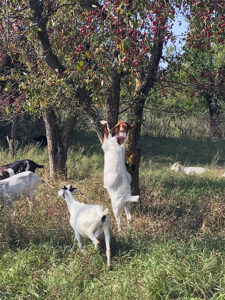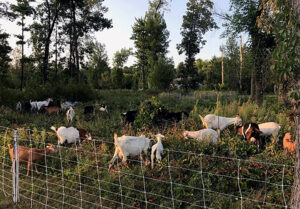
Grazing goats can reach as high as six feet to munch on leaves, which they prefer to grasses and stems. Photo: Wisconsin DNR.
Art Kabelowsky, DNR Forest Health outreach and communications specialist
Arthur.Kabelowsky@wisconsin.gov or 608-335-0167
“Who do you know wants to rent a goat?”
Milwaukee television viewers of a certain age might recognize that twist on the old commercial slogan of automobile dealer Ernie Von Schledorn: “Who do you know wants to buy a car?”
Although Ernie is no longer around, the idea of having foresters use goat grazing to control interfering vegetation remains in use.
It’s a discussion worth talking about — and listening to.
Goat grazing was the topic of a recent edition of SilviCast, a monthly podcast about silviculture produced as part of a collaborative effort between the Wisconsin Department of Natural Resources (DNR) and the Wisconsin Forestry Center, based at the University of Wisconsin-Stevens Point.
The regular on-air hosts of the podcast are DNR silviculturists Greg Edge and Brad Hutnik, who invite guests to join the discussion on each month’s topic. The podcast is in its fourth season since debuting in June 2020.

HaakHagen Goat Grazing LLC provides 40 or 50 goats in a fenced-in area, and the goats’ grazing removes interfering vegetation, whether native or invasive. Photo: Wisconsin DNR.
Their monthly podcasts, available at sites such as Apple Podcasts, Spotify, Google Podcasts and others, are available at no charge. Listeners can even earn continuing education credits for a fee by taking a quiz after each podcast.
The December 2022 SilviCast, titled “Woodlot Assassins,” addressed the benefits and challenges of using targeted goat grazing as a silvicultural tool to battle interfering vegetation, whether native or invasive.
Their guests were Greg Haak and Brooke Hushagen of HaakHagen Goat Grazing LLC. Both work for the DNR and are based in Poynette — Hushagen as a forestry technician and Haak at the state game farm.
Their company, already booked through the 2023 grazing season, provides goats to gobble up invasive plants, allowing the landowner to avoid chemicals, heavy equipment rental or burning.
A herd of 40 to 50 goats is set up in a fenced target area, where Haak says they can work through an acre of plants in a week or less. Multiple grazing visits over time stress the plants enough that their presence is greatly diminished in time.
While SilviCast has a wide range of monthly topics on the science of silviculture, Edge and Hutnik returned to the concept of silvopasture for their May SilviCast, which discussed the combined management of livestock and woods. The guest for that SilviCast was Rich Straight, the technology transfer leader for the U.S. Forest Service’s National Agroforestry Center.
Straight defined silvopasture as the intentional integration of trees, forage and livestock, in a coordinated effort on the same piece of land.
Prior SilviCast episodes mentioned ecological silviculture, the recovery of white pine, the importance of forest carbon and forestry herbicides.
